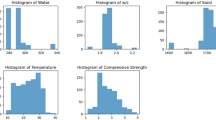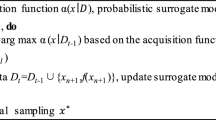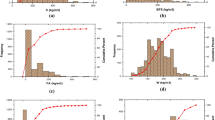Abstract
Self-compacting concrete (SCC) has transformed civil engineering by efficiently filling formwork without mechanical consolidation, enhancing construction efficiency, and durability, and reducing labor needs. Accurate prediction of compressive strength (CS), a crucial mechanical property, is essential for optimal results. The complex nature of SCC mixtures has led researchers to explore modern days tool like machine learning and artificial intelligence. This study assesses six machine learning techniques (MLTs) by coupling long-established AI algorithms like artificial neural network (ANN), adaptive neuro-fuzzy inference system (ANFIS), and extreme learning machine (ELM) with nature-inspired optimization algorithms like moth flame optimization algorithm (MOFA) and wild horse optimizer (WHO). Addressing gaps in input parameter consistency, dataset standardization, and model comparison, the results demonstrate high accuracy in CS prediction for all six models, with ELM tuned with MFOA consistently outperforming others in various metrics. Visual representations validate model effectiveness, suggesting potential benefits such as improved quality control, reduced costs, and enhanced safety. This research contributes to MLT applications in construction materials, highlighting ELM–MOFA as a preferred model for CS prediction in SCC.













Similar content being viewed by others
Data availability
The data and supplementary material are available on request.
References
Ahmad, W., Ahmad, A., Ostrowski, K. A., Aslam, F., Joyklad, P., & Zajdel, P. (2021). Application of advanced machine learning approaches to predict the compressive strength of concrete containing supplementary cementitious materials. Materials, 14(19), 5762.
Aicha, M. B., Al Asri, Y., Zaher, M., Alaoui, A. H., & Burtschell, Y. (2022). Prediction of rheological behavior of self-compacting concrete by multi-variable regression and artificial neural networks. Powder Technology, 401, 117345.
Al-Shamiri, A. K., Kim, J. H., Yuan, T. F., & Yoon, Y. S. (2019). Modeling the compressive strength of high-strength concrete: An extreme learning approach. Construction and Building Materials, 208, 204–219.
Amin, M. N., Al-Hashem, M. N., Ahmad, A., Khan, K., Ahmad, W., Qadir, M. G., & Al-Ahmad, Q. (2022). Application of soft-computing methods to evaluate the compressive strength of self-compacting concrete. Materials, 15(21), 7800.
Arora, S., Jangra, P., Lim, Y. Y., & Pham, T. M. (2023). Strength, durability, and microstructure of self-compacting geopolymer concrete produced with copper slag aggregates. Environmental Science and Pollution Research, 30(1), 666–684.
Aslani, F., Ma, G., Wan, D. L. Y., & Muselin, G. (2018). Development of high-performance self-compacting concrete using waste recycled concrete aggregates and rubber granules. Journal of Cleaner Production, 182, 553–566.
Belalia Douma, O., Boukhatem, B., Ghrici, M., & Tagnit-Hamou, A. (2017). Prediction of properties of self-compacting concrete containing fly ash using artificial neural network. Neural Computing and Applications, 28, 707–718.
Buragohain, M., & Mahanta, C. (2008). A novel approach for ANFIS modelling based on full factorial design. Applied Soft Computing, 8(1), 609–625.
Chen, Z., Iftikhar, B., Ahmad, A., Dodo, Y., Abuhussain, M. A., Althoey, F., & Sufian, M. (2023). Strength evaluation of eco-friendly waste-derived self-compacting concrete via interpretable genetic-based machine learning models. Materials Today Communications, 37, 107356.
De-Prado-Gil, J., Palencia, C., Silva-Monteiro, N., & Martínez-García, R. (2022). To predict the compressive strength of self compacting concrete with recycled aggregates utilizing ensemble machine learning models. Case Studies in Construction Materials, 16, e01046.
Dey, S., Kumar, V. P., Goud, K. R., & Basha, S. K. J. (2021). State of art review on self compacting concrete using mineral admixtures. Journal of Building Pathology and Rehabilitation, 6(1), 18.
Dutta, S., Murthy, A. R., Kim, D., & Samui, P. (2017). Prediction of compressive strength of self-compacting concrete using intelligent computational modeling. Computers, Materials & Continua, 53(2), 167–185.
El Asri, Y., Aicha, M. B., Zaher, M., & Alaoui, A. H. (2022). Prediction of compressive strength of self-compacting concrete using four machine learning technics. Materials Today: Proceedings, 57, 859–866.
Ghani, S., & Kumari, S. (2023). Prediction of soil liquefaction for railway embankment resting on fine soil deposits using enhanced machine learning techniques. Journal of Earth System Science, 132(3), 1–23.
Ghani, S., Kumari, S., & Bardhan, A. (2021). A novel liquefaction study for fine-grained soil using PCA-based hybrid soft computing models. Sādhanā, 46(3), 113.
Ghani, S., Kumari, S., Jaiswal, S., & Sawant, V. A. (2022). Comparative and parametric study of AI-based models for risk assessment against soil liquefaction for high-intensity earthquakes. Arabian Journal of Geosciences, 15(14), 1262.
Hoang, N. D. (2022). Machine learning-based estimation of the compressive strength of self-compacting concrete: A multi-dataset study. Mathematics, 10(20), 3771.
Huang, G. B., Zhu, Q. Y., & Siew, C. K. (2006). Extreme learning machine: Theory and applications. Neurocomputing, 70(1–3), 489–501.
Jibril, M. M., Malami, S. I., Muhammad, U. J., Bashir, A., Usman, A. G., Salami, B. A., & Abba, S. I. (2023). High strength concrete compressive strength prediction using an evolutionary computational intelligence algorithm. Asian Journal of Civil Engineering. https://doi.org/10.1007/s42107-023-00746-7
Kar, S., Pandit, A. R., & Biswal, K. C. (2021). A neuro-fuzzy approach to estimate the shear contribution of externally bonded FRP composites. Asian Journal of Civil Engineering, 22, 351–367.
Kashem, A., & Das, P. (2023). Compressive strength prediction of high-strength concrete using hybrid machine learning approaches by incorporating SHAP analysis. Asian Journal of Civil Engineering. https://doi.org/10.1007/s42107-023-00707-0
Kashyap, V., Poddar, A., Sihag, P., & Kumar, B. (2023). Forecasting compressive strength of jute fiber reinforced concrete using ANFIS, ANN, RF and RT models. Asian Journal of Civil Engineering. https://doi.org/10.1007/s42107-023-00892-y
Kaveh, A., DadrasEslamlou, A., Javadi, S. M., & Geran Malek, N. (2021). Machine learning regression approaches for predicting the ultimate buckling load of variable-stiffness composite cylinders. Acta Mechanica, 232, 921–931.
Kaveh, A., Eskandari, A., & Movasat, M. (2023). Buckling resistance prediction of high-strength steel columns using metaheuristic-trained artificial neural networks. Structures, 56, 104853.
Kaveh, A., Gholipour, Y., & Rahami, H. (2008). Optimal design of transmission towers using genetic algorithm and neural networks. International Journal of Space Structures, 23(1), 1–19.
Linardatos, P., Papastefanopoulos, V., & Kotsiantis, S. (2020). Explainable ai: A review of machine learning interpretability methods. Entropy, 23(1), 18.
Ly, H. B., Nguyen, T. A., Pham, B. T., & Nguyen, M. H. (2022). A hybrid machine learning model to estimate self-compacting concrete compressive strength. Frontiers of Structural and Civil Engineering, 16(8), 990–1002.
Nguyen-Sy, T., Wakim, J., To, Q. D., Vu, M. N., Nguyen, T. D., & Nguyen, T. T. (2020). Predicting the compressive strength of concrete from its compositions and age using the extreme gradient boosting method. Construction and Building Materials, 260, 119757.
Panda, K. C., & Bal, P. K. (2013). Properties of self compacting concrete using recycled coarse aggregate. Procedia Engineering, 51, 159–164.
Rajakarunakaran, S. A., Lourdu, A. R., Muthusamy, S., Panchal, H., Alrubaie, A. J., Jaber, M. M., & Ali, S. H. M. (2022). Prediction of strength and analysis in self-compacting concrete using machine learning based regression techniques. Advances in Engineering Software, 173, 103267.
Ramkumar, K. B., Rajkumar, P. K., Ahmmad, S. N., & Jegan, M. (2020). A review on performance of self-compacting concrete–use of mineral admixtures and steel fibres with artificial neural network application. Construction and Building Materials, 261, 120215.
Rofooei, F. R., Kaveh, A., & Farahani, F. M. (2011). Estimating the vulnerability of the concrete moment resisting frame structures using artificial neural networks. International Journal of Optimization Civil Engineering, 1(3), 433–448.
Sadek, D. M., El-Attar, M. M., & Ali, H. A. (2016). Reusing of marble and granite powders in self-compacting concrete for sustainable development. Journal of Cleaner Production, 121, 19–32.
Sahoo, S. K., Saha, A. K., Nama, S., & Masdari, M. (2023). An improved moth flame optimization algorithm based on modified dynamic opposite learning strategy. Artificial Intelligence Review, 56, 2811–2869. https://doi.org/10.1007/s10462-022-10218-0
Sarker, I. H. (2021). Machine learning: Algorithms, real-world applications and research directions. SN Computer Science, 2(3), 160.
Shah, S. N. R., Siddiqui, G. R., & Pathan, N. (2023). Predicting the behaviour of self-compacting concrete incorporating agro-industrial waste using experimental investigations and comparative machine learning modelling. Structures, 52, 536–548.
Shi, C., Wu, Z., Lv, K., & Wu, L. (2015). A review on mixture design methods for self-compacting concrete. Construction and Building Materials, 84, 387–398.
Sonebi, M., Cevik, A., Grünewald, S., & Walraven, J. (2016). Modelling the fresh properties of self-compacting concrete using support vector machine approach. Construction and Building Materials, 106, 55–64.
Tran, V. Q., Mai, H. V. T., Nguyen, T. A., & Ly, H. B. (2022). Assessment of different machine learning techniques in predicting the compressive strength of self-compacting concrete. Frontiers of Structural and Civil Engineering, 16(7), 928–945.
Yaman, M. A., Abd Elaty, M., & Taman, M. (2017). Predicting the ingredients of self compacting concrete using artificial neural network. Alexandria Engineering Journal, 56(4), 523–532.
Yaseen, Z. M., Deo, R. C., Hilal, A., Abd, A. M., Bueno, L. C., Salcedo-Sanz, S., & Nehdi, M. L. (2018). Predicting compressive strength of lightweight foamed concrete using extreme learning machine model. Advances in Engineering Software, 115, 112–125.
Zeng, C., Qin, T., Tan, W., et al. (2023). Coverage optimization of heterogeneous wireless sensor network based on improved wild horse optimizer. Biomimetics, 8, 70. https://doi.org/10.3390/biomimetics8010070
Acknowledgements
Not applicable.
Funding
No funding was obtained for this study.
Author information
Authors and Affiliations
Contributions
SG: conceptualization, machine learning application and interpretation of ML results, finalizing the draft. NK: conceptualization, results compilation, and writing the first draft. MG: Experimental investigation, data collection, processing of results, and writing the first draft. SS: processing, results compilation, and writing the first draft.
Corresponding author
Ethics declarations
Conflict of interest
On behalf of all authors, the corresponding author states that there is no conflict of interest.
Ethical approval
Not applicable.
Additional information
Publisher's Note
Springer Nature remains neutral with regard to jurisdictional claims in published maps and institutional affiliations.
Rights and permissions
Springer Nature or its licensor (e.g. a society or other partner) holds exclusive rights to this article under a publishing agreement with the author(s) or other rightsholder(s); author self-archiving of the accepted manuscript version of this article is solely governed by the terms of such publishing agreement and applicable law.
About this article
Cite this article
Ghani, S., Kumar, N., Gupta, M. et al. Machine learning approaches for real-time prediction of compressive strength in self-compacting concrete. Asian J Civ Eng 25, 2743–2760 (2024). https://doi.org/10.1007/s42107-023-00942-5
Received:
Accepted:
Published:
Issue Date:
DOI: https://doi.org/10.1007/s42107-023-00942-5




